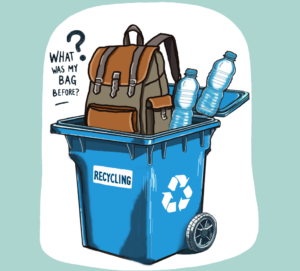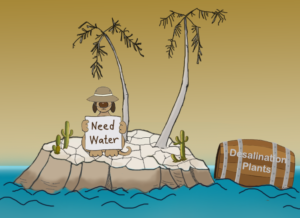
“Thick black peanut butter,” Nishan Degnarain describes the sticky, controversial Heavy Fuel Oil (HFO), also known as bunker or residual fuel oil with a density exceeding 900 kg/m3 at 15 degrees Celsius (Heavy Fuel Oil (HFO) | Lubmarine, n.d.). It’s known for its heavy, thick tar-like consistency and widespread use in vessels and maritime activities. In fact, approximately 60% of ocean-bound large vessels, including cargo ships, ferries, oil tankers, bulk carriers, and cruise ships, use heavy fuel oil (Degnarain, 2020). The widespread use of heavy fuel oils is attributed to their cost and availability. After more refined petroleum products are distilled from crude, heavy fuel oils are essentially the sludge left over, making them an accessible and cheaper alternative to distillates like diesel and gasoline. In addition to their high energy characteristics, these factors have made HFOs a very popular choice for maritime activities since the mid-19th century.
In this paper, I will discuss the consequences of heavy fuel oils as marine fuel on our health and the environment. Then, I will discuss the IMO 2020 regulation put into place with the intention of minimizing the detrimental effect of sulfur dioxide, and review the efficacy and consequences of the regulation itself. Lastly, I will provide alternative solutions and recommendations for how the matter of sulfur emissions from ships should be handled in the future.
Since heavy fuel oils are remnants of the crude cracking process, they have high concentrations of compounds like sulfur, nitrogen, and aromatics, making them one of the dirtiest fuel sources and a major contributor to greenhouse gas emissions. In particular, the combustion of HFOs produces sulfur dioxide SO2 due to their high sulfur contamination. Before 2020, 13% of global sulfur emissions were produced by shipping (Miller, 2023). However, sulfur dioxide is much more than just a pungent, stinky, and colorless gas; it poses serious health risks. Exposure to sulfur dioxide is primarily through inhalation, usually from air pollution. The gas reacts with mucous membranes when inhaled to form severe irritants like sulfurous acid, according to the CDC (ATSDR Agency for Toxic Substances and Disease Registry, n.d.). It can aggravate asthma, emphysema, and other chronic pulmonary diseases, even at very low concentrations. Severe corneal damage or even frostbite injury can occur when directly exposed to the skin or eye to compressed gas or liquid SO2. When looking at the combined effects of all emissions from vessels, the estimated premature deaths from global shipping-sourced emissions were over 265,000 in 2020 (Mueller et al., 2023) and millions of cases of childhood asthma (Ulrich, 2019).
The effects of sulfur emissions on the environment are also detrimental. For example, when sulfur dioxide reacts with the water in the clouds in our atmosphere, it creates sulfuric acid. When the acid mixes with water and precipitates back down to earth, this is known as acid rain. Acid rain poses threats to agriculture: washing away nutrients in the ground and altering the composition of the soil. It can also damage the outer layer of plant leaves and inhibit plant growth. Furthermore, acid rain can also endanger species with low tolerance to changes in pH (Witchalls, 2022), decreasing biodiversity and even leading to the collapse of ecosystems. In particular, aquatic ecosystems like streams and lakes are vulnerable to the ecological impact of acid rain.
Given its adverse effects on both human and environmental health, global leaders have agreed on some regulations to reduce or minimize the sulfur emitted into the atmosphere from maritime activities. On January 1, 2020, the International Maritime Organization (IMO) imposed a limit on the concentration of sulfur, called the IMO 2020. The IMO 2020 reduced sulfur concentrations from 3.5% mass by mass to 0.50% mass by mass on board ships operating outside emission control areas, whose limits were at 0.10%. At a glance, this global regulation seemed to be highly effective, facilitating a 77% drop in overall SOx emissions from ships—that’s equivalent to a reduction of around 8.5 metric tons of SOx annually. The predicted benefits included a positive impact on human health, cleaner air, and more ships switching to higher-quality low-sulfur oil (IMO International Maritime Organization, n.d.). However, it was not as clear-cut of a solution as it seemed.
First and foremost, there’s a loophole in the IMO 2020 regulation: scrubbers. To comply with the sulfur limit, ships are permitted to install exhaust gas cleaning devices, known as “Exhaust Gas Cleaning Systems (EGCS)” or “scrubbers.” Most ships use a popular type of scrubber called the “open-loop” scrubber. The open-loop scrubber essentially pumps and sprays seawater into the exhaust. The water, usually untreated, is discharged back into the ocean while the scrubbed exhaust is released into the air. And this untreated water is, by no means, harmless. For ships using open-loop scrubbers, approximately 45 tons of acidic water contaminated with carcinogens like PAHs are emitted for every ton of fuel burned (ICCT, The International Council on Clean Transportation, 2023). These carcinogens are detrimental to the health of marine ecosystems. Ultimately, the implementation of open-loop scrubbers is simply redirecting pollutants from the sky to the ocean. In other words, this approach to reduce sulfur emissions does not tackle the problem from a broad lens. Instead, it only focuses specifically on pollutants released into the atmosphere. What the regulation doesn’t focus on is the acidic and contaminated scrubber water polluting pristine areas and harming marine ecosystems. In fact, 180 million tonnes of contaminated scrub water were projected to be discharged from cruise ships that used open-loop scrubbers to compensate for HFO use in 2020 (ICCT The International Council on Clean Transportation, 2023). This is a clear violation of the agreements made at the 1982 United Nations Convention on the Law of the Sea (UNCLOS) that specifically prohibited states from converting one form of pollution into another to preserve the marine environment (UNITED NATIONS, 2019).
Thus, scrubbers have faced increased opposition. The ICCT policy updates reveal that 93 measures were implemented in 45 countries to regulate scrubber wash water (ICCT The International Council on Clean Transportation, 2023). Many parts of the world, like China, the UAE, Malaysia, India, and Belgium, have implemented bans or restrictions. However, open-loop scrubbers remain popular amongst ship operators because they can save up to 60 billion dollars a year instead of switching to a low-sulfur fuel (Saraogi, 2020). As a result, organizations like Stand.Earth are calling for the IMO to “impose a moratorium on the use of scrubbers and to close this loophole that puts people and the planet at serious risk” (Ulrich, 2019). Without further restrictions, the ideal option for ship operators would be to choose open-loop scrubbers rather than fully comply with IMO 2020 regulations.
Aside from the direct consequences like redirecting pollution, the limit placed on sulfur emissions also has broader implications in the context of climate change. Especially in the past few years, the recent spikes in global temperatures have raised increased concerns about the possible factors that are accelerating this warming. Interestingly, many claim it is associated with sulfur regulation, pointing to evidence that aerosols have a cooling influence on greenhouse gas warming. SO2 is an atmospheric aerosol, which is a solid or liquid microscopic particle in our atmosphere. While natural sources include sea spray, desert dust, wildfire smoke, and volcanoes, most anthropogenic aerosol emissions are from the combustion of fossil fuels. Aerosols reduce solar radiation from reaching the lower atmospheric layers by either scattering, absorbing, or reflecting sunlight, thus having a direct cooling effect. Aerosols also play important roles as cloud condensation nuclei through a cloud albedo effect when the aerosols in the clouds make them brighter and thus block more sunlight from reaching the surface of the earth (NASA, 2010). But their contribution to global cooling remains uncertain and still up for debate by scientists. Their uncertainty is largely due to other variables and factors; for example, the Hunga Tonga volcanic eruption in 2022 could have played a role in the warming of the atmosphere rather than solely the reduction of SO2. Other factors include the Saharan dust scarcity and El Niño pattern changes. Europe drastically reduced industrial SO2 emissions, yet the data is confounded by COVID-19 pandemics and other factors that may have reduced transportation (Copernicus, 2023). On the other hand, Carbon Brief analysis reveals that the 2020 regulations could possibly “increase global temperatures by around 0.05 degrees Celsius by 2050,” which is roughly equivalent to “two additional years of emissions” (Carbon Brief, 2023). Some geoengineering projects are even proposing the release of SO2 into the atmosphere as a targeted strategy aiming to mitigate global warming.
It’s clear that the IMO 2020 regulation was not entirely successful. Yes, its implementation was unprecedentedly quick. And the reduced SO2 emissions in the atmosphere have most likely decreased respiratory and cardiovascular problems and prevented ecological damage from acidification to some extent. However, on the other hand, its scrubber loophole still enables the pollution of wastewater into the ocean and does little to convince ship operators to truly comply with the regulations. In addition, although it remains uncertain, there is a possibility that the very reduction of sulfur emissions is speeding up the warming of the climate. Ultimately, we can conclude that the IMO 2020 is clearly insufficient. We must push for stronger regulations that close the scrubber loopholes. Banning scrubbers entirely would give ship operators no choice but to transition from heavy fuel oils to alternative fuels like LNG, LPG, or hydrogen. The government should also further subsidize research and the development of battery systems or even propulsion technology using green energy like wind. In the broader context of aerosol’s impact on global cooling, scientists should continue to use maritime activities and emission data to observe the potential drivers of climate change. Issues like these are multifaceted and intersectional. The discussion of human and planetary health is and will continue to be an important one, especially in the coming years. Even the most ideal solution is not ideal for everyone and may have many defects as well. What’s necessary is the collaboration from all the critical groups involved. Whether it’s health experts, policy makers, civilians, or ship operators, it’s crucial to construct a shared vision, negotiate, and work together to address these problems. For now, it’s best to say goodbye to “thick black peanut butter.”
References
ATSDR Agency for Toxic Substances and Disease Registry. (n.d.). Sulfur Dioxide | Medical Management Guidelines | Toxic Substance Portal | ATSDR. Wwwn.cdc.gov. https://wwwn.cdc.gov/TSP/MMG/MMGDetails.aspx?mmgid=249&toxid=46#:~:text=Sulfur%20dioxide%20is%20a%20severe%20irritant%20to%20the%20respiratory%20tract
CAICE. (n.d.). Introduction to Aerosols. CAICE. Retrieved November 23, 2023, from https://caice.ucsd.edu/introduction-to-aerosols/#:~:text=There%20are%20many%20sources%20of
Copernicus. (2023, August 1). Aerosols: are SO2 emissions reductions contributing to global warming? | Copernicus. Atmosphere.copernicus.eu. https://atmosphere.copernicus.eu/aerosols-are-so2-emissions-reductions-contributing-global-warming
Degnarain, N. (2020, August 14). What Is Heavy Fuel Oil, And Why Is It So Controversial? Five Killer Facts. Forbes. https://www.forbes.com/sites/nishandegnarain/2020/08/14/what-is-heavy-fuel-oil-and-why-is-it-so-controversial-five-killer-facts/?sh=34df87f274c0
Evans, P. (2009, April 24). Big polluters: one massive container ship equals 50 million cars. New Atlas. https://newatlas.com/shipping-pollution/11526/
Heavy Fuel Oil (HFO) | Lubmarine. (n.d.). Lubmarine.totalenergies.com. https://lubmarine.totalenergies.com/faq/glossary/heavy-fuel-oil-hfo#:~:text=In%20the%20MARPOL%20Marine%20Convention
Hines, M. (2020, September 17). “Failing or close to it”: Environmental organization gives cruise industry poor report card. USA TODAY. https://www.usatoday.com/story/travel/cruises/2020/09/17/carnival-corp-cruise-lines-fail-environment-report-card/5805383002/
ICCT The International Council on Clean Transportation. (2023). POLICY UPDATE Global update on scrubber bans and restrictions. https://theicct.org/wp-content/uploads/2023/06/Scrubbers_policy_update_final.pdf
IMO International Maritime Organization. (n.d.). IMO2020 fuel oil sulphur limit – cleaner air, healthier planet. Imopublicsite.azurewebsites.net. https://www.imo.org/en/MediaCentre/PressBriefings/pages/02-IMO-2020.aspx#:~:text=entering%20into%20force.-
Law of the Sea Convention. (n.d.). Www.noaa.gov. https://www.noaa.gov/law-of-sea-convention#:~:text=The%201982%20Law%20of%20the
Loeb, V. (2023, July 17). A Shipping Rule Backfires, Diverting Sulfur Emissions From the Air to the Ocean. Inside Climate News. https://insideclimatenews.org/news/17072023/ship-scrubbers-water-pollution/
Lunde Hermansson, A., Hassellöv, I.-M., Jalkanen, J.-P., & Ytreberg, E. (2023). Cumulative environmental risk assessment of metals and polycyclic aromatic hydrocarbons from ship activities in ports. Marine Pollution Bulletin, 189, 114805. https://doi.org/10.1016/j.marpolbul.2023.114805
Miller, G. (2023, July 12). Is IMO 2020 shipping regulation worsening global warming? FreightWaves. https://www.freightwaves.com/news/is-imo-2020-shipping-regulation-worsening-global-warming
Mueller, N., Westerby, M., & Nieuwenhuijsen, M. (2023). Health impact assessments of shipping and port-sourced air pollution on a global scale: A scoping literature review. Environmental Research, 216, 114460. https://doi.org/10.1016/j.envres.2022.114460
NASA. (2010, November 2). Aerosols: Tiny Particles, Big Impact. Nasa.gov; NASA Earth Observatory. https://earthobservatory.nasa.gov/features/Aerosols/page4.php
Saraogi, V. (2020, January 8). Debunking: the problem of ships using open-loop scrubbers. Ship Technology. https://www.ship-technology.com/features/open-loop-scubbers/?cf-view
Staff, C. B. (2023, July 3). Analysis: How low-sulphur shipping rules are affecting global warming. Carbon Brief. https://www.carbonbrief.org/analysis-how-low-sulphur-shipping-rules-are-affecting-global-warming/#:~:text=Globally%2C%20SO2%20emissions%20from%20marine
Ulrich, K. (2019, December 23). New ban on high-sulfur ship fuel = big benefits for people & the planet (if it weren’t for that massive loophole!). Stand.earth. https://stand.earth/insights/new-ban-on-high-sulfur-ship-fuel-big-benefits-for-people-the-planet-if-it-werent-for-that-massive-loophole/#:~:text=It
UNITED NATIONS. (2019). UNCLOS and Agreement on Part XI – Preamble and frame index. Un.org. https://www.un.org/Depts/los/convention_agreements/texts/unclos/closindx.htm
United Nations. (2012). Overview – Convention & Related Agreements. Un.org. https://www.un.org/Depts/los/convention_agreements/convention_overview_convention.htm
Walker, J. (2023, November 2). Turning Air Pollution Into Water Pollution: Carnival Magic Dumps Scrubber Sludge in Grand Turk Waters. Cruise Law News. https://www.cruiselawnews.com/2023/11/articles/pollution/turning-air-pollution-into-water-pollution-carnival-magic-dumps-scrubber-sludge-in-grand-turk-waters/
Wisconsin Department of Health Services. (2018, January 30). Sulfur dioxide. Wisconsin Department of Health Services. https://www.dhs.wisconsin.gov/chemical/sulfurdioxide.htm#:~:text=It%20is%20produced%20from%20theWitchalls, S. (2022, March 27). How Does Acid Rain Affect the Environment. Earth.org – Past | Present | Future. https://earth.org/how-does-acid-rain-affect-the-environment/
The views and opinions expressed are those of the authors and do not necessarily reflect nor represent the Earth Chronicles and its editorial board.




